Gear and Techniques for Successful Kindergarten Photography

Gear and Techniques for Successful Kindergarten Photography
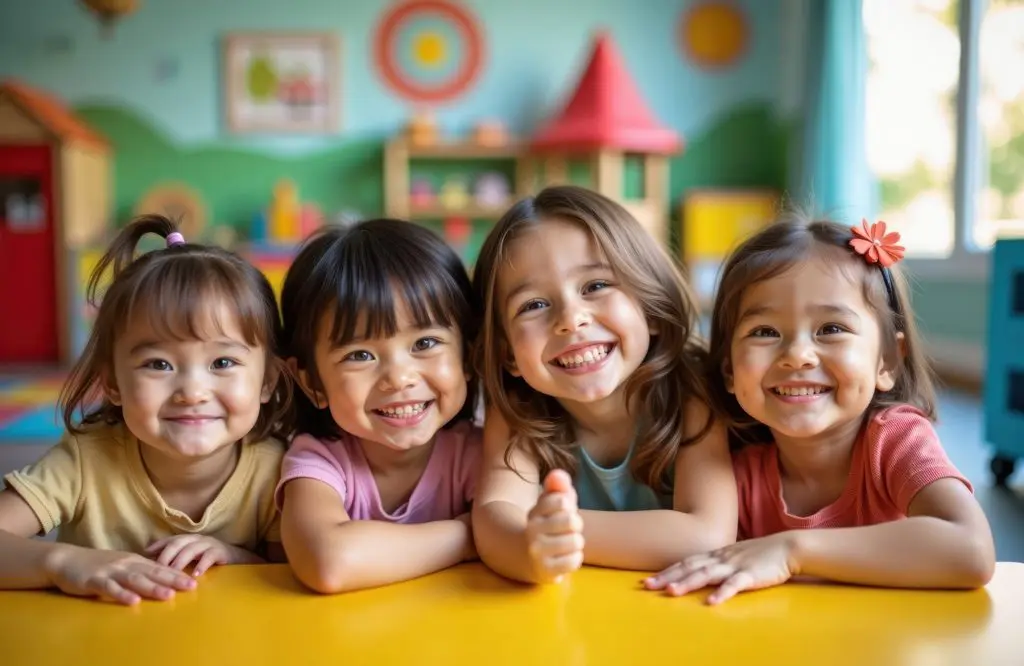
Capturing authentic, joy-filled moments in a kindergarten setting takes more than just a good eye—it requires the right tools and techniques. As a professional kindergarten photographer, your job is to move with ease through dynamic environments, anticipate fleeting expressions, and stay ready to document the spontaneity that defines childhood. A successful kindergarten photography session is built on thoughtful preparation, reliable gear, and interaction skills that allow kids to be themselves in front of the lens.
This article dives into the practical aspects of becoming a trusted photographer for kindergarten or daycare settings. Whether you’re refining your existing workflow or just beginning to explore this niche, these gear tips and field-tested techniques will help you elevate every kindergarten photo you take.
Essential Gear for Kindergarten Photography
Cameras and Lenses That Make a Difference
To deliver high-quality kindergarten photography results, your gear must be up to the task—quiet, responsive, and adaptable.
Modern mirrorless cameras are a favorite among daycare photographers for several reasons. Models like the Canon R6/R8, Sony A7 series, or Nikon Z6 II offer lightning-fast autofocus, excellent high-ISO performance for low-light indoor scenes, and—perhaps most importantly—silent shutter modes. During a kindergarten photo shoot, a camera that doesn’t click loudly is a must. It helps you remain unobtrusive while children play, paint, or listen to a story. Silent shooting keeps the atmosphere relaxed and reduces the chance that a child will stop a natural moment just because they heard the camera.
For lenses, versatility is key. A high-quality 24–70mm f/2.8 zoom lens is ideal for most kindergarten photoshoots—it covers wide classroom scenes and tight portraits without needing to switch gear. Prime lenses like a 35mm f/1.8 or 50mm f/1.4 offer beautiful background blur (bokeh) and extra light-gathering ability for indoor daycare photography where flash is not appropriate.
If you shoot with two camera bodies, consider pairing a wide zoom on one and a portrait-length prime (like 85mm f/1.8) on the other. This setup gives you flexibility without needing to swap lenses mid-session, which is especially helpful during fast-paced kindergarten photoshoots.
Additional Accessories for a Smooth Workflow
When photographing dozens of energetic children in one day, it’s the little things that keep you going. Always carry extra batteries and memory cards, as mirrorless cameras can go through batteries quickly, and high-speed burst mode fills cards fast.
Use a comfortable camera strap or harness like a cross-body sling or dual camera harness to allow for long sessions without back strain, and avoid gear that dangles or swings—curious children may grab it.
Equip your gear with lens hoods and UV filters for protection against fingerprints, toy collisions, or accidental drops at kid-height. Keep microfiber cloths and wipes on hand to clean lenses and hands when needed, since kindergartens are messy environments.
When it comes to lighting, simplicity wins. Most kindergarten photography sessions rely on available natural light. However, for portraits in dim areas, a small bounce flash or LED panel can help. Always bounce flash off a ceiling or wall to keep light soft and non-intrusive. Avoid heavy strobes or large light modifiers unless you’re in a controlled setup like a mobile portrait station.
Protective gear is also essential. Think about bringing a kneeling pad, compact stool, or comfortable shoes with cushioning—you’ll be crouching, sitting, and moving constantly during a kindergarten photoshoot.
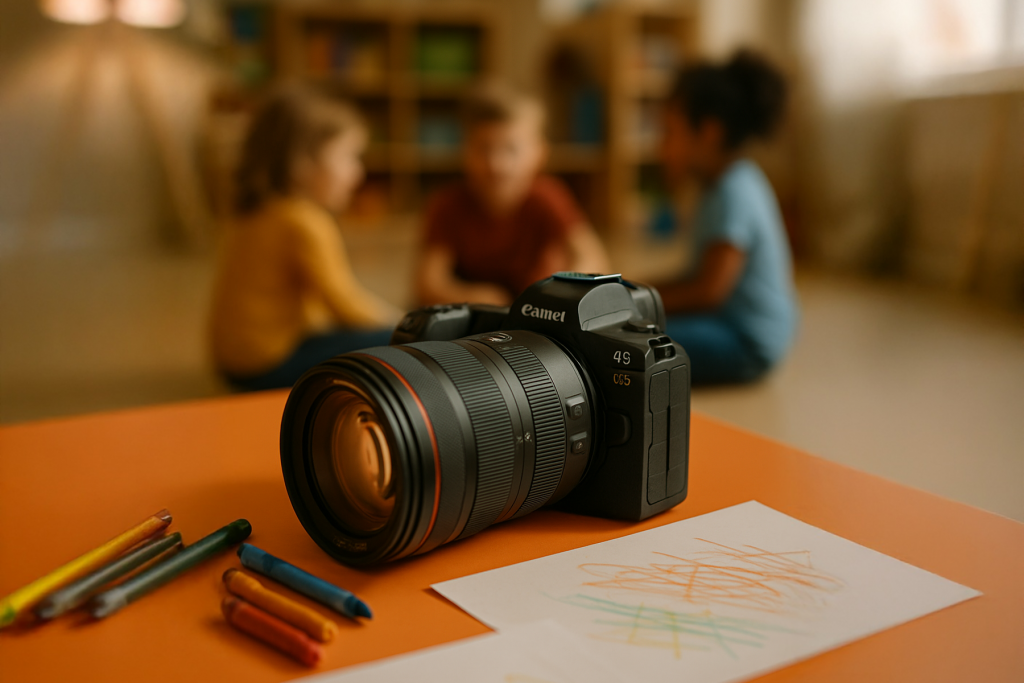
Techniques for Capturing Authentic Moments
Blend Into Their World
The secret to candid kindergarten photography isn’t invisibility—it’s familiarity. Children feel more comfortable when you’re a warm, approachable presence rather than a mysterious adult behind a camera.
Arrive early to introduce yourself during morning activities or circle time. Sit at their level, engage in a game, or join them in coloring. Once the kids have accepted your presence, you can begin documenting quietly.
Positioning your camera at the children’s eye level makes a huge visual difference. Shots taken from standing adult height feel distant and disconnected. Kneeling or even lying on the floor makes every kindergarten photo more immersive and emotionally connected.
Be present but unobtrusive. Children should feel that you’re a part of their world—not someone observing from the sidelines. This balance allows you to capture unguarded expressions and real moments that define excellent kindergarten photography.
Smart Camera Settings for Fast Action
Young children are wonderfully unpredictable, which makes technical readiness essential.
To increase your success rate, use burst mode (high-speed continuous shooting) to catch fast sequences, as one out of five frames might have the perfect smile or laugh.
Set your focus to continuous autofocus (AF-C) with eye or face detection, especially when kids are moving—this setting is vital for every kindergarten photoshoot. Use a fast shutter speed (1/250s or faster) to freeze action; if children are running or jumping, 1/500s or more may be needed. In low light, raise your ISO confidently. Modern cameras perform well even at ISO 3200 or higher, which allows you to shoot indoors without flash.
Creative angles also help enrich your portfolio. Try overhead shots of kids huddled around an activity or low angles that emphasize their size and world. Panning techniques (moving the camera with a fast-moving child) can create motion blur backgrounds while keeping the subject sharp—great for dynamic kindergarten photoshoot ideas.
Creative Interactions That Spark Natural Reactions
Sometimes you need to gently guide the moment without forcing it. That’s where interactive techniques come in.
Try simple prompts like “Can you show me your biggest silly face?” or “Let’s pretend we’re butterflies!”.
Engage them in spontaneous group games like Simon Says, freeze dance, or a photo scavenger hunt (e.g., “Find something red and show it to me!”).
Use small props like bubbles, puppets, or funny hats to grab attention and spark emotion.
These techniques help avoid stiff, posed shots while still delivering structure. Kids who are nervous about being photographed often relax when they’re given a task or game to focus on—this makes for some of the best daycare photography moments.
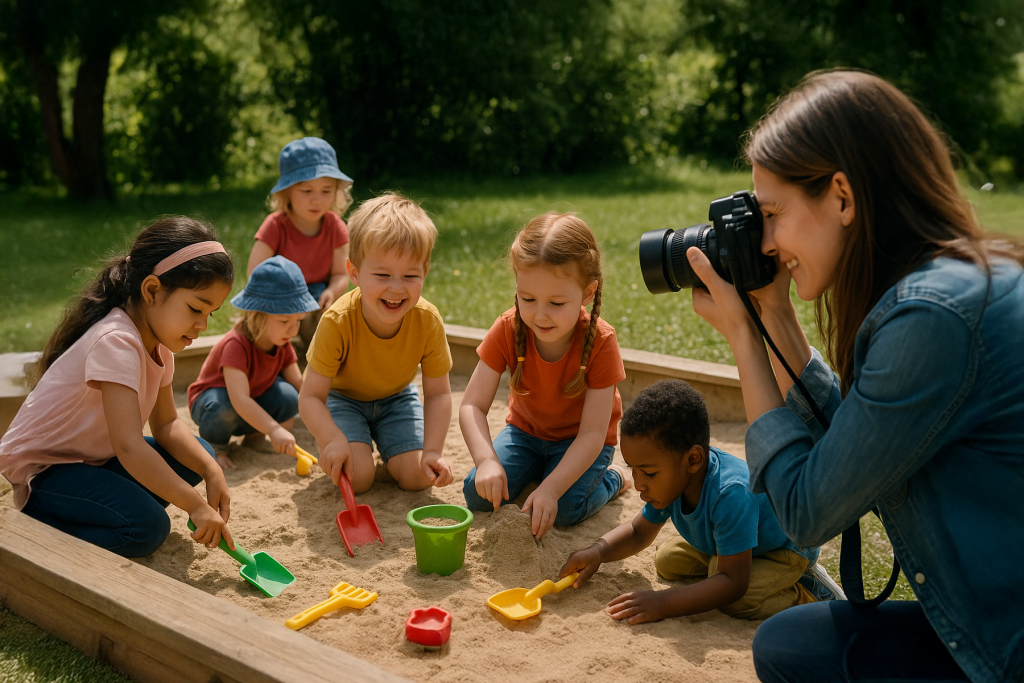
Efficient Editing and Post-Processing Workflow
Selecting the Best Shots: Fast and Focused Culling
After a kindergarten photoshoot, you may have 500–1500 images per day. Efficient culling is your first step.
Use tools like Adobe Lightroom Classic or Photo Mechanic to quickly review images. Flag your favorites based on sharpness, emotion, and expression. Group photos by child or class if needed.
Start with a rough first pass—don’t overanalyze. The goal is to identify obvious keepers. Then refine further, narrowing it down to the strongest selections for each child and group scene. A clean, curated gallery featuring 3–6 standout images per child (plus candids and group shots) often performs better than an overwhelming number of similar images.
Consistent and Clean Edits
Once you’ve selected your images, aim for a uniform editing style across the entire collection. This gives your final gallery a professional, cohesive look.
Focus your adjustments on exposure and white balance correction for natural skin tones, gentle contrast and color vibrancy to retain a cheerful, warm look, cropping and straightening for clean compositions, and mild sharpening and noise reduction as needed.
Avoid over-editing or trendy filters—parents want timeless images. A neutral, true-to-life edit suits kindergarten photography best, especially if the images are being printed or included in a school album.
If you work with varied lighting (indoor classroom vs. outdoor play), create different presets for each condition and apply them in batches.
AI Tools to Supercharge Your Workflow
When working as a kindergarten photographer, your editing time can quickly balloon without automation. That’s where smart AI tools come in.
When working with Lightroom, Neurapix offers you an AI-powered editing assistant that learns your personal style and can apply it to entire galleries – with impressive speed. Once Neurapix has been trained with an example of your edited images, it automatically transfers your editing method to the entire image collection. Up to 1000 images per minute can be edited this way – ideal when you’re handling large daycare projects.
Neurapix ensures consistent, high-quality results while giving you more time to focus on creative or manual touch-ups. It’s a powerful solution for anyone who wants to scale their business or simply spend less time behind a screen and more time behind the lens.
Delivering the Photos Professionally
Organized and Secure Proofing
Once your images are edited and polished, how you deliver them plays a major role in the overall client experience. Whether you’re working with a small daycare or a large kindergarten with multiple classes, streamlined, professional delivery helps solidify your reputation as a reliable kindergarten photographer.
Most modern photographers use online gallery platforms like Pixieset, SmugMug, or dedicated school photography tools. These allow you to upload galleries by class or individual child, protect images with login codes or passwords, and let parents view and order prints or digital downloads directly.
When setting up your gallery, label everything clearly. For example, “Class A – Spring 2025” or “Lena M. – Portraits & Candids.” The more intuitive the experience, the more likely parents are to engage quickly.
Some photographers still use printed proofs with physical order forms—especially if schools or families prefer offline options. In that case, make sure your contact details and ordering instructions are crystal clear, and that proof images are cleanly presented with visible image codes.
Whichever route you choose, make sure to communicate a timeline. Let families know when galleries go live, when orders are due, and when to expect their prints or digital files.
Offering Prints, Digital Files, and Albums
As a daycare photographer, your delivery options should cater to both emotional value and modern convenience.”It makes sense to offer different packages – for example:
- Prints in standard sizes (e.g., 13–18cm, 20–30cm, class photo)
- Web-optimized digital downloads
- High-resolution digital files for printing at home
- Optional kindergarten photo album products
Albums are especially appealing. You can offer mini albums for each child or a collective class album for the school. These tell a richer story and can be cherished for years. Parents love having a tangible keepsake that captures more than just a posed smile—it captures moments, friendships, and milestones.
When offering albums, consider using playful but clean layouts, chronological storytelling (e.g., indoor play, outdoor play, group activities), and ensure each child is featured at least once in a candid moment. These small touches help elevate your kindergarten photography service from good to memorable.
Add the Final Personal Touch
A handwritten thank-you card, a free group photo print for the school, or a short behind-the-scenes blog post on your website (without naming or showing identifiable children unless permitted) can go a long way. These personal touches create goodwill and help build long-term relationships with schools and parents.
If you share highlights on social media (again, with appropriate consent), tag the school and use relevant hashtags like #kindergartenphotography or #daycarephotographer. This helps with local visibility and marketing for your services.
Conclusion and Call-to-Action
Being a successful kindergarten photographer is equal parts technical preparation, emotional intelligence, and creative adaptability. When you combine the right tools with thoughtful techniques and streamlined delivery, you’re able to offer a complete, joyful, and professional kindergarten photography experience.
From your gear—silent cameras, versatile lenses, and helpful accessories—to your methods for blending in and evoking genuine expressions, everything contributes to a photoshoot that feels natural and relaxed. Add to that a consistent, efficient post-processing workflow and a polished delivery experience, and you’ve built a reliable and sustainable approach that meets the needs of both parents and institutions.
The next time you step into a kindergarten or daycare center, know that you’re doing more than documenting a few smiling faces. You’re capturing fleeting moments that families will treasure for a lifetime—finger paint on cheeks, bubble-blowing giggles, proud masterpieces held high. These are the building blocks of memory, and your camera is the tool that preserves them.
So, whether you’re refining your skills or launching into this rewarding niche, take these kindergarten photoshoot ideas, workflows, and gear recommendations with you. Use them to elevate your next session—and remind yourself why this kind of photography is so meaningful.
If you want to know how to perfectly present your finished shots, continue to the next article. There you’ll learn how to complete your work with high quality and appeal – for lasting impressions on parents and institutions.
Related Posts
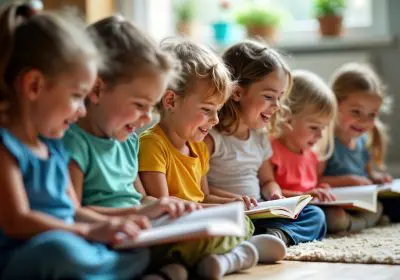
Delivering Beautiful Results: Prints, Digital Galleries, and Photo Albums
After the planning, shooting, and editing are complete, the final step in every successful kindergarten…
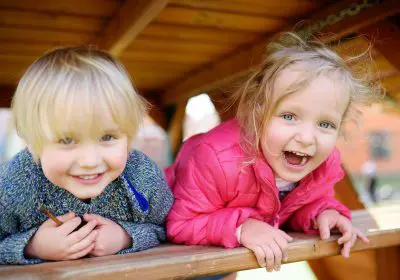
Modern Candid Kindergarten Photography: Capturing Real Moments That Matter
Modern candid kindergarten photography is revolutionizing how we document early childhood. Gone are the days…

Advanced LR Photo Editing: Mastering Local Adjustments, Color Grading & AI Tools
Once you’ve grasped the fundamentals of Lightroom—presets, batch editing, and basic color correction—it’s time to…
